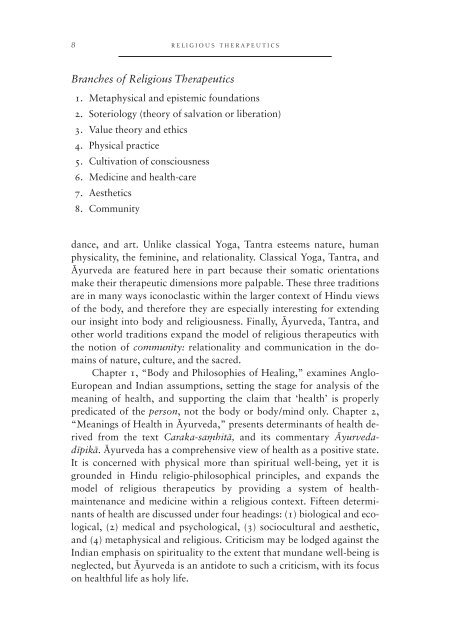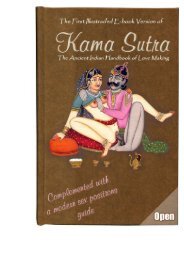body and health in yoga, Ayurveda, and Tantra
body and health in yoga, Ayurveda, and Tantra
body and health in yoga, Ayurveda, and Tantra
Create successful ePaper yourself
Turn your PDF publications into a flip-book with our unique Google optimized e-Paper software.
8 religious therapeutics<br />
Branches of Religious Therapeutics<br />
1. Metaphysical <strong>and</strong> epistemic foundations<br />
2. Soteriology (theory of salvation or liberation)<br />
3. Value theory <strong>and</strong> ethics<br />
4. Physical practice<br />
5. Cultivation of consciousness<br />
6. Medic<strong>in</strong>e <strong>and</strong> <strong>health</strong>-care<br />
7. Aesthetics<br />
8. Community<br />
dance, <strong>and</strong> art. Unlike classical Yoga, <strong>Tantra</strong> esteems nature, human<br />
physicality, the fem<strong>in</strong><strong>in</strong>e, <strong>and</strong> relationality. Classical Yoga, <strong>Tantra</strong>, <strong>and</strong><br />
Åyurveda are featured here <strong>in</strong> part because their somatic orientations<br />
make their therapeutic dimensions more palpable. These three traditions<br />
are <strong>in</strong> many ways iconoclastic with<strong>in</strong> the larger context of H<strong>in</strong>du views<br />
of the <strong>body</strong>, <strong>and</strong> therefore they are especially <strong>in</strong>terest<strong>in</strong>g for extend<strong>in</strong>g<br />
our <strong>in</strong>sight <strong>in</strong>to <strong>body</strong> <strong>and</strong> religiousness. F<strong>in</strong>ally, Åyurveda, <strong>Tantra</strong>, <strong>and</strong><br />
other world traditions exp<strong>and</strong> the model of religious therapeutics with<br />
the notion of community: relationality <strong>and</strong> communication <strong>in</strong> the doma<strong>in</strong>s<br />
of nature, culture, <strong>and</strong> the sacred.<br />
Chapter 1, “Body <strong>and</strong> Philosophies of Heal<strong>in</strong>g,” exam<strong>in</strong>es Anglo-<br />
European <strong>and</strong> Indian assumptions, sett<strong>in</strong>g the stage for analysis of the<br />
mean<strong>in</strong>g of <strong>health</strong>, <strong>and</strong> support<strong>in</strong>g the claim that ‘<strong>health</strong>’ is properly<br />
predicated of the person, not the <strong>body</strong> or <strong>body</strong>/m<strong>in</strong>d only. Chapter 2,<br />
“Mean<strong>in</strong>gs of Health <strong>in</strong> Åyurveda,” presents determ<strong>in</strong>ants of <strong>health</strong> derived<br />
from the text Caraka-saÓmhitā, <strong>and</strong> its commentary Åyurvedad¯ıpikā.<br />
Åyurveda has a comprehensive view of <strong>health</strong> as a positive state.<br />
It is concerned with physical more than spiritual well-be<strong>in</strong>g, yet it is<br />
grounded <strong>in</strong> H<strong>in</strong>du religio-philosophical pr<strong>in</strong>ciples, <strong>and</strong> exp<strong>and</strong>s the<br />
model of religious therapeutics by provid<strong>in</strong>g a system of <strong>health</strong>ma<strong>in</strong>tenance<br />
<strong>and</strong> medic<strong>in</strong>e with<strong>in</strong> a religious context. Fifteen determ<strong>in</strong>ants<br />
of <strong>health</strong> are discussed under four head<strong>in</strong>gs: (1) biological <strong>and</strong> ecological,<br />
(2) medical <strong>and</strong> psychological, (3) sociocultural <strong>and</strong> aesthetic,<br />
<strong>and</strong> (4) metaphysical <strong>and</strong> religious. Criticism may be lodged aga<strong>in</strong>st the<br />
Indian emphasis on spirituality to the extent that mundane well-be<strong>in</strong>g is<br />
neglected, but Åyurveda is an antidote to such a criticism, with its focus<br />
on <strong>health</strong>ful life as holy life.



